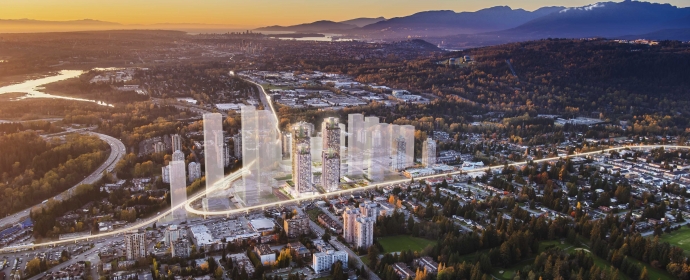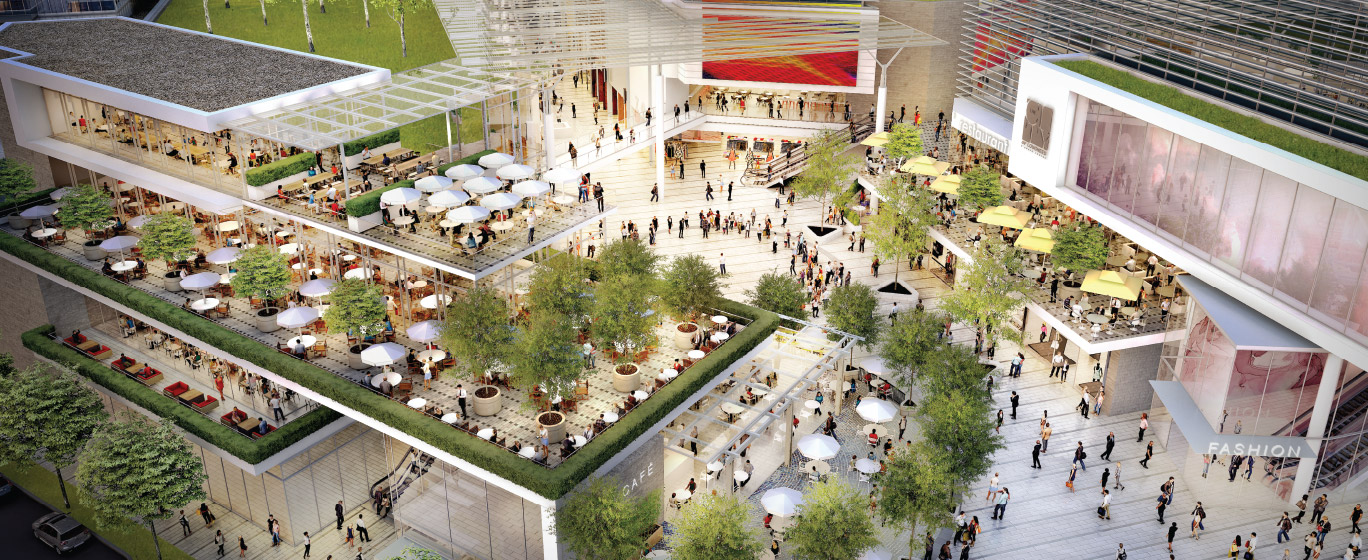As transportation (bike lanes!!) appears to be receding as a hot cultural change issue, housing density’s noise level is rising. This arguement won’t likely get quite so hot, and may take much longer to resolve. What with the Provincial Gov’t (and all its allies, stooges and agents) continuing to argue the case for (and massively fund) sprawl, strip malls, freeways and paving farmland for cheesy suburbs. After all, it worked just fine in the case of the Burrard Bridge (Kits and Dunbar become suburbs), Lions Gate Bridge (opened up North and West Vancouver to car-oriented development); Oak Street Bridge (thousands of acres of Richmond farmland), the Massey Tunnel and so on.
Here’s a few things going on.
 First, this from UBC Professor Nathanael Lauster “Abandon the Dream Home… You’ll Be Happier“. He argues along a familiar track — too much land is devoted to housing too few people. He discusses Vancouver as a city pointing to the future of more diverse development, with a long way to go. And he’s not one to cloak his thoughts in fluffy words:
First, this from UBC Professor Nathanael Lauster “Abandon the Dream Home… You’ll Be Happier“. He argues along a familiar track — too much land is devoted to housing too few people. He discusses Vancouver as a city pointing to the future of more diverse development, with a long way to go. And he’s not one to cloak his thoughts in fluffy words:
He calls the single-family house an “invasive parasite.”
“I’m not opposed to the house as part of a set of broader, diverse ways of living in the city,” Lauster insists, “but I am opposed to regulations that set aside land for houses and houses alone.” Too many houses, he argues, are bad for cities, bad for urban dwellers, and bad for diversity. . .
. . .Before policy can open those areas to more diversity in housing, Lauster says, a cultural shift is needed, “redefining what it means to be a success.” Today’s parents, he says, need to accept that kids can grow up healthy and happy without doing it in a house.
“Making that culture shift is trickier than making policy shifts,” he said. “But I think policy shifts help us move towards that culture shift.”
With thanks to Christopher Cheung in The Tyee.
Prof Lauster has a book on the subject “The Death and Life of the Single-Family House“. It’s introduction is HERE.
Next, the City of Lougheed: your local, friendly $7 B transit-oriented development: a 40-acre site in Burnaby being turned into a neighbourhood of 23 high-rise dwellings (25-65 stories), walkable central galleria cum boulevards, major mall and so on. Eventually to deliver 11,000 residential units, over a period of 30 years.

Thanks to Kenneth Chan at VanCity Buzz for this overview of the City of Lougheed. And to Michael Kluckner for his thoughts on it earlier this year in Price Tags.
It’s a big dollar vote by Shape Living in favour of compact and dense development, that makes me happy to see, along with its focus on transportation alternatives. This in stark contrast to the Tsawassen Mills car-dependent sprawl-oriented mall and adjacent car suburb, which in my mind are at serious risk of failure. And I’m hoping that the Jericho and Heather developments will go dense and transit-oriented, and not follow in the Tsawassen mold.
Fueled by infrastructure investments and improved transportation access, Shape Living’s master-planned City Centres are strategically located on SkyTrain’s rapid transit lines, providing residents with unsurpassed connections to Vancouver’s downtown core, YVR and beyond. Our bold developments will thrive from the success of SkyTrain’s $1.6 billion Millennium Line as well as the construction of the $1.4 billion Evergreen Line. By positioning homes directly on transit, we offer a sustainable way to live and freedom from car ownership.

And last, thoughts from elsewhere on density and reshaping the city continue to pop up. “Waking Up to Shorter Commutes” in the New York Times discusses transportation funding in the USA.
On Nov. 8, there will be about 45 ballot proposals across the country that could raise nearly $200 billion for transportation improvements.
Many local officials say they have no choice but to raise taxes to invest in transportation, especially in mass transit, because their highways are clogged and more people are moving to cities.













Would be interesting to know what neighbourhood Dr. Lauster lives in.
And whether or not he lives in a single family home.
Probably not in one of the lovely Burnaby town centres.
Most multi-family developments in Metro Vancouver are not family friendly – poor sound insulation between units, no courtyards or other spaces for playing.
Professor Lauster’s assessment perpetrates a number of fallacies and, it seems to me, is based on a social, or political view rather than sound policy. First of all, we do not have a density issue in Vancouver. We have an issue with housing being built and marketed as places for overseas investors to put their money. In fact, we have had record construction of new condos in the last while and yet we are still meant to believe that we have a density crisis. If density were the issue, then surely all this new construction would have addressed it, but it hasn’t and the reason is obvious.
This key fact undermines the whole notion that we have to address housing by pointing the finger at Single Family Dwellings (SFD). Any city needs a balance of housing types and that includes neighbourhoods with SFD’s. Even London has many neighbourhoods with SFD’s and London’s congestion is way worse than Vancouver’s.
There is no reason to vilify SFD’s and try to say that somehow, we need to tell people that they should not aspire to them or that they should feel guilty about wanting to. If you can manage to build your way up to living in a SFD, then good for you. We don’t need to create a Hong Kong style city of towers in Vancouver. Well, not more than we already have!
The London comparison is not helpful since London (and other parts of England) has a housing shortage and a strong tradition of single-family and row houses – similar to Canada.
Vancouver’s housing types, whether marketed offshore or not, is not diverse enough to make that judgment. In addition, one of the key elements often glossed over or ignored in the density / affordability debate is poor land use efficiency. Pointing out that 30% of our housing stock consumes 80% of the land in this town does not constitute a war on SFDHs. It merely states a fact and identifies the basis for future improvements in land use efficiency and the potential to vastly increase the choice of housing.
In the last few years, SFD’s have increased their density threefold by allowing laneway housing and getting rid of “illegal suites” so that basements can be rented legitimately. Tripling potential density in all SFD’s is significant, so why is this figure ignored? That is not poor land use.
The writer is not merely pointing out that 30% of our housing stock consumes 80% of our land, he is actively advocating against the notion of the SFD and suggesting we should change our priorities and not aspire or seek to want to live in them. It’s very clearly more of a moral view, or a class based view, than one borne out of the actual needs. There is much we can do with zoning and efficiencies in the city which would allow for more varied development. No one is saying not to touch any SFD’s, but what we see, for instance, is the loss of affordable housing, knocked down and replaced with high end housing which is far less affordable to many.
In Kits, zoning forbids the construction of homes bigger than the footprint of any existing home, but that’s only part of Kits, so outside of that zone, we see homes routinely torn down and replaced with huge ones. That is not necessarily a bad thing all the time, but the point is that we can do many things to improve this situation without excessive densification or espousing the view that there is some inherent wrong with the SFD. There isn’t. Any city needs balance.
It’s like some here at Price Tags who feel that we need more bike infrastructure to support safe cycling. We do, but others feel that we need to get rid of cars from our roads. That’s not balanced or sharing and is never going to happen. In the same way, we are not going to see the wholesale removal of the SFD and we shouldn’t, so why advocate for it as this writer has?
A couple further thoughts on what seem to be glaring inconsistencies in Lauster’s piece. He asks “why we set aside 80% of the land aside for millionaires”, rather than ask: why has a single family home become the sole purview of millionaires over the last ten years? Odd, considering he’s written on immigration. If he has only been in the city a decade or so, perhaps he doesn’t realize that community active, engaged middle class homeowners were once the rule rather than the exception.
Second, given that he has studied the immigration issue why does he refer to a “North American obsession” with the single family home? If anything, the experience of the last ten years has shown us other cultures are just as enamoured with the house as preferred residential type as North Americans!
Very good points which further illustrate the lack of depth in his thesis.